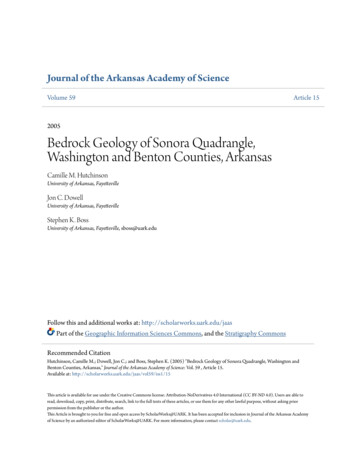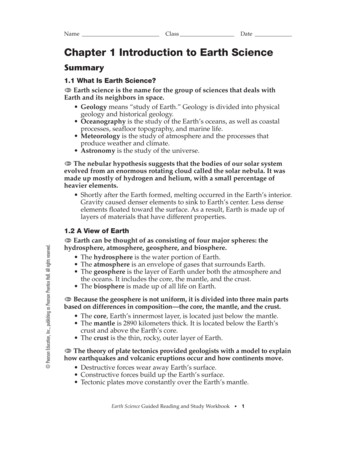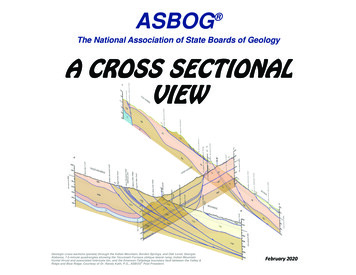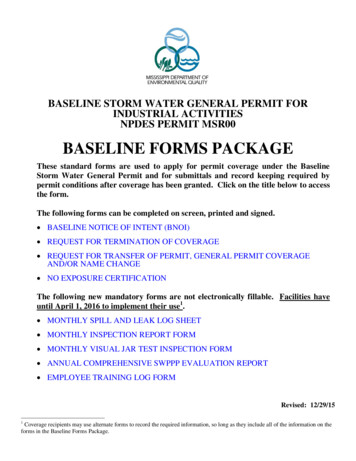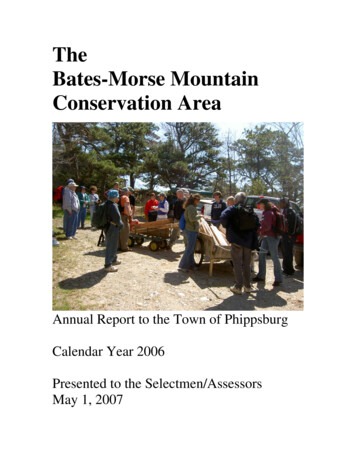
Transcription
A Geology of thePlatteville QuadrangleWisconsintv:i"Si"o!O3ODQt OEUGEOLOGICALSURVEYBULLETINPrepared in cooperation with theWisconsin Geological andNatural History Survey1123-E
Geology of thePlatteville QuadrangleWisconsinBy ALLEN F. AGNEWGEOLOGY OF PARTS OF THE UPPER MISSISSIPPIVALLEY ZINC-LEAD DISTRICTGEOLOGICALSURVEYBULLETIN1123-EPrepared in cooperation with theWisconsin Geological andNatural History SurveyUNITED STATES GOVERNMENT PRINTING OFFICE, WASHINGTON : 1963
UNITED STATES DEPARTMENT OF THE INTERIO*STEWART L. UDALL, SecretaryGEOLOGICAL SURVEYThomas B. Nolan, DirectorFor sale by the Superintendent of Documents, U.S. Government Printing OfficeWashington, D.G. 20402
CONTENTSArAbstract- . - - - - - - --. . . - --- ----Introduction. . - - . . . .Physiography. -- - - - - - . . . . .Stratigraphy- ----- -- - -- - - - - - - -- . - -Precambrian rocks.Cambrian rocks. - - - - . -- .Ordovician system. - -- -- -.-- . . - . - - . . .Prairie du Chien group- : . .St. Peter sandstone -- - .Platteville formation. - . - - . . . . . .Glenwood shale and Pecatonica dolomite membersMcGregor limestone member.Quimbys Mill member,.Decorah formationSpechts Ferry shale member. - ----- -------.Guttenberg limestone member . - . . -- - .Ion dolomite member.Galena dolomite ---- - - - - ---- - ---.Cherty unit - -- .- - .Noncherty unit . - . - - .Maquoketa shale ---- --- - - . -- - - . Post-Ordovician depositsStructure- - -- - - -- --- - - - ---- - --- -.Folds. -------------------- ----- -- - - ----------- --- Faults. --Joints-.---------.--------.-.------- . -. . .-- -- .Mineral deposits.-- --- - . --- - . . - - - - - .Metallic deposits (zinc, lead, iron)History and production.Vertical veins (crevice deposits) -Inclined and horizontal veins (pitch-and-flat deposits) .Zinc mines . - . - - --- - .Iron sulfide deposits - - - -- --Rock alteration related to ore deposits - --- -----Origin of the ore deposits- - -- - --- -- ------Exploration for ore deposits . - -- - - --Nonmetallic deposits. - - - - - --- --- ---References cited. - --- - - - - - -- - -- 4265269270271272274275
IVCONTENTSn USTKATIONSPagePLATE 19. Geologic map of the Platteville quadrangle. -- In pocketFIGURE 38. Index map of the Wisconsin-Illinois-Iowa zinc-lead district.24739. Areas of the Platteville quadrangle mapped in previoussurveys - - - - - - - ---- ---- --- - 24840. Generalized stratigraphic columnar section of rocks exposedin the Platteville quadrangle.25141. Total joints, crevices, and shears in the Platteville quadrangle. . . .- - .- -. - . -.26042. Plat showing location of vertical-vein (crevice) lead depositsmapped in the Platteville quadrangle268TABLETABLE 1. Location of zinc mines in the Platteville quadrangle,- -Page268
GEOLOGY OF PARTS OF THE UPPER MISSISSIPPI VALLEY ZINC-LEADDISTRICTGEOLOGY OF THE PLATTEVILLE QUADRANGLE,WISCONSINBy ALLEN F. AGNEWABSTRACTThe Platteville quadrangle is in southwest Wisconsin, in the WisconsinIllinois-Iowa zinc-lead district. Sedimentary rocks exposed in the quadrangleare, in ascending order: the upper members of the Platteville formation, theDecorah formation, and the Galena dolomite, all of Middle Ordovician age,and the Maquoketa shale of Late Ordovician age. Bocks penetrated by drillholes and wells but not exposed are, in ascending order: Precambrian graniticrocks; sandstone, siltstone, and dolomite of Late Cambrian age; the Prairiedu Chien group of Early Ordovician age; the St. Peter sandstone of MiddleOrdovician age; and the lower members of the Platteville formation. Loess ofQuaternary age and a residual mantle of soil cover the bedrock.The rocks have a slight regional dip southwestward and are warped by gentlefolds that strike northeastward or northwestward and average about 30 feetin amplitude. Locally, the amplitudes of small folds may be increased or decreased through leaching of carbonate rocks by mineralizing solutions. Partof the north limb of the Meekers Grove anticline, a fold having about 140 feetof structural relief, underlies the southeastern part of the quadrangle. Jointsand small faults parallel the small folds or diverge from their trends at a smallangle; joints that are most open strike eastward.Metallic mineral deposits include zinc, lead, and iron minerals. Verticalveins (crevice deposits) contain principally galena; some contain smithsonitenear the water table and sphalerite below it. Most of the lead ore producedwas from the second and upper flint openings in the Galena dolomite, alongsolution-widened vertical or steeply inclined fractures. Concentrations of galena occur in residual clay above or near crevice deposits.Zinc ore occurs in inclined and horizontal veins (pitch-and-flat deposits) andin related solution breccia and disseminated deposits. These are found in thelower part of the Galena dolomite, in the Decorah formation, and in the Quimbys Mill member of the Platteville formation; the fractures that control themare related to folding. Sphalerite is accompanied by a gangue of pyrite, marcasite, calcite, and barite; oxidation has produced secondary carbonates, oxides,and sulfates. The iron sulfides are a potential source of sulfur. Alteration ofthe host rocks by leaching, thinning, dolomitization, and some silicification isrelated to mineralization.Nonmetallic mineral deposits include barite that occurs with the metallicminerals, building stone, clays, cement materials, road aggregate, agriculturallimestone, and soils.245
246GEOLOGY OF TIPPER MISSISSIPPI VALLEY ZINC-LEAD DISTRICTINTRODUCTIONThe Platteville quadrangle, part of the Wisconsin-Illinois-Iowazinc-lead district, contains about 54 square miles in eastern Grant andwestern Lafayette Counties, Wis. (fig. 38). It lies wholly within theDriftless Area (Whitney, 1862, p. 117-120; Shaw and Trowbridge,1916, fig. 3). The principal city, Platteville, is in the northwestcorner of the quadrangle.Important contributions to the geology of the Upper MississippiValley mining district and thus to the geology of the Plattevillequadrangle were made by Owen (1840), Daniels (1854), Percival(1855, 1856), Whitney (1862), Strong (1877), Chamberlin (1882),Grant (1903), and Bain (1906). Parts of the quadrangle weremapped (fig. 39) by Grant (1906, pis. 10, 16), Grant and Burchard(1907), Steidtmann (1909, pis. 1-3), and Heyl and others (1945).The geology of the Platteville quadrangle (pi. 19) was mappedin cooperation with the Wisconsin Geological and Natural HistorySurvey as part of a geologic study of the zinc-lead district (Heyl andothers, 1959). The study includes surface geologic mapping and detailed investigation of mines. Detailed geologic studies of small areasof extensive mining and exploration made between 1942 and 1951,together with the present mapping program, indicate potentialitiesfor future exploration for zinc-lead ore deposits.Field mapping of the Platteville quadrangle began in July 1952and ended in November 1953. A compilation of field data fromaerial photos was made on a base map at a scale of 1:7,920. Theadditional information and new interpretations have revised geologicboundaries and structure shown on older maps of the area. Thestructure contours shown on plate 19 are based on detailed stratigraphic studies of outcrops and on examination of cuttings fromprospect holes and water wells drilled by individuals and miningcompanies, and from holes drilled by the U.S. Geological Survey(Agnew, 1953). Altitudes of exposed rocks and of many drill-holecollars were surveyed by planetable and alidade and this informationwas reduced to a common datum surface, the top of the Plattevilleformation. In certain areas, as sees. 13 and 24, T. 3 N., R. 1 W., thestructure contours are based mainly on the Steidtmann (1909) surveybecause these areas do not contain useful outcrops or recent drill holes.The author gratefully acknowledges the cooperation of W. N. Smithand 0. E. DeWitt of the Vinegar Hill Zinc Co.; J. M. Hague andR. B. Paul of the New Jersey Zinc Co.; C. T. Millice of the AmericanZinc, Lead, and Smelting Co.; and C. W. Stoops, an independentmine operator in Platteville. These men and the companies they represent aided the study of the Platteville quadrangle by furnishing
GEOLOGY OF PLATTEVILLE QUADRANGLE, WISCONSIN.H 2 § JCLXIdI2470 I 2(f §1O"oc O Q.IISI§"0fc aIs*2SOsM 4s58
248GEOLOGY OF UPPER MISSISSIPPI VALLEY ZINC-LEAD DISTRICTdrill:hole and mine data. The writer is indebted to his colleagues ofthe U.S. Geological Survey for their assistance, suggestions, and critical comments in the preparation of this report, especially to Thomas E.Mullens.//////////////////////////.I//HEYL, AGNEW AND BEHRE (1945)II APPROXIMATE MEANDECLINATION, 1962STEIDTMANN (1909. PL 1)5GRANT(1906, PL 16ctCo:0\ MILEFIGURE 39. Areas of the Plattevllle quadrangle mapped In previous surveys.
GEOLOGY OF PLATTEVILLE QUADRANGLE, WISCONSIN249PHYSIOGRAPHYThe topography of the Driftless Area, which differs markedly fromthat of the surrounding glaciated region, was described by Irving(1877, p. 610-611) and by Chamberlin and Salisbury (1885); Owen(1840) had earlier noted the absence of drift in the mining district.The topographic surface of the Platteville quadrangle is in the erosional stage of early maturity. The maximum altitude is 1,170 feet,in the northeastern corner of the quadrangle, and the minimum is 790feet, in the southwestern part, but local topographic relief does notexceed 165 feet. The valleys are generally broad with gentle slopesand flat bottomlands. The eastern part of the quadrangle is drainedby the southward-flowing Galena (Fever) Kiver, and the western partis drained by several westward-flowing tributaries of the Little PlatteRiver. Both rivers are tributary to the Mississippi.The summits of the interfluvial areas of the quadrangle appear to beaccordant, and the upland surface slopes southward. The amplitudesof minor folds are too small to disclose accurately any possible bevelingof structure by the upland surface; however, the major Meekers Groveanticline, along the south edge of the Platteville quadrangle, is beveledby the general southward topographic slope. This surface may represent a partly dissected peneplain (Martin, 1916, p. 55-70); Trowbridge, 1921); but because of the general similarity of its slope (17 feetper mile) to the regional dip (16 feet per mile) as reported by Agnew(1955, p. 784), the surface is herein interpreted as structural.Uplands are mainly farmland and grassland. Most stream valleysare covered with grassland, although some are bordered by smallwoodlots.STRATIGRAPHYBedrock units exposed in the Platteville quadrangle are, in ascending order: the McGregor and Quimbys Mill members of the Plattevilleformation, the Decorah formation, and the Galena dolomite, all ofMiddle Ordovician age, and the Maquoketa shale of Late Ordovicianage. Also exposed are loess of Quaternary age, chert gravel of undetermined age, and quartz sandstone that fills joints in the Galenadolomite and is of undetermined age.Pre-Platteville rocks, although not exposed in the quadrangle, havebeen penetrated by drill holes and are also known from exposuresnearby. They lie on a Precambrian granitic basement and include,in ascending order: the Dresbach group, Franconia sandstone, andTrempealeau formation, all of Late Cambrian age; the Prairie du663375 622
250GEOLOGY OF UPPER MISSISSIPPI VALLEY ZINC-LEAD DISTRICTChien group of Early Ordovician age; the St. Peter sandstone ofMiddle Ordovician age; and the Glenwood shale and Pecatonica dolomite members of the Platteville formation, also of Middle Ordovicianage.The general nature of the stratigraphic units is presented in theparagraphs that follow. For detailed lithology of the exposed rockssee figure 40, and for regional relations of these rocks see Agnew andothers (1956).PRECAMBRIAN ROCKSAn igneous and metamorphic complex of granite, gneiss, schist, andquartzite forms the pre-Paleozoic basement in southwestern Wisconsin (Thwaites, 1931). Within the Platteville quadrangle Precambrian"granite" was reported at the depth of 1,714 feet in Platteville citywell 2 (NW1/4SE14 sec. 14, T. 3 N., K. 1 W.). Precambrian rockshave been penetrated by deep wells elsewhere in the mining district(Anderson, 1950).CAMBRIAN ROCKSInformation concerning Cambrian strata was obtained by examination of drill cuttings from city wells 2 and 3 at Platteville, and fromNo. 2 at Cuba City, which is l1/ miles south of the Platteville quadrangle. The principal data are tabulated below.Generalized description of Cambrian rocks underlying the Platteville andstoneDresbachgroupGales villesandstoneEau ClairesandstoneMount SimonsandstoneLithologyThickness(feet)Sandstone, dolomite, dolomitic siltstone.--- 142-155Sandstone, locally dolomitic siltstone, andsandy shale; glauconitic.91-115135-162Dolomitic sandstone, shale. - . - 111-355Sandstone - - . - .-- - - --778
GEOLOGY OF PLATTEVILLE QUADRANGLE, WISCONSINEXPLANATIONDolmite, with ReceptaculitesLimestone, nodular shaly Limestone, nodular fossiliferousLimestone, phosphate nodulesLimestone lenses251
252GEOLOGY OF UPPER MISSISSIPPI VALLEY ZINC-LEAD DISTRICTORDOVICIAN SYSTEMPRAIRIE DU CHIEN GROUPThe Prairie du Chien group of Early Ordovician age is not exposedin the Platteville quadrangle but it was penetrated by the Plattevillecity wells and by eight other wells not more than 14 miles from thequadrangle. Upper beds of the Prairie du Chien crop out alongthe Pecatonica River about 10 miles northeast of Platteville and alongthe Little Platte River about 3 miles north of Platteville. The complete section of the Prairie du Chien is exposed about 30 miles northof Platteville in the bluffs along the Wisconsin River; there it conformably overlies the Trempealeau formation.Well cuttings from four of the localities including Plattevilleshowed a typical sequence of brown to yellowish-gray fine-graineddolomite locally contained nodules or irregular masses of gray chert.This typical Prairie du Chien is 207 to 225 feet thick near Plattevilleand 255 to 267 feet near Cuba City. The other well cuttings showan anomalous combination of red and green shale, sandstone, chert,silicified limestone, and limestone at the stratigraphic position of thePrairie du Chien group. These strata have been considered a partof the Prairie du Chien (Flint, 1956) or the basal part of the overlying St. Peter sandstone (Heyl and others, 1951, p. 15).In two wells near Cuba City, pyrite and marcasite were in cuttingsfrom the lower 47 to 85 feet of normal dolomite of the Prairie duChien. This, and evidence in other parts of the mining district, showsthat dolomite in the Prairie du Chien is a potentially favorable hostrock for iron, zinc, and lead sulfide deposits (Heyl and others, 1951;Agnew and others, 1953, p. 7-11).ST. PETER SANDSTONEThe St. Peter sandstone of Middle Ordovician age is not exposedin the Platteville quadrangle, but it crops out in stream valleys lessthan 1 mile from the southeastern and northwestern corners of thequadrangle. Additional information regarding the St. Peter wasobtained from the records of the wells mentioned in the discussionof the Prairie du Chien group.The St. Peter is a very clean quartz sandstone that is generallywell sorted and averages 50 feet in thickness. Where rock that resembles St. Peter sandstone occupies part of the Prairie du Chieninterval, as at the well localities cited above, the thickness of the St.Peter sandstone, or at least of sandstone like the St. Peter, rangesfrom 138 to 320 feet. In some places the upper 40 to 60 feet of thissandstone is better sorted than the rest; in other places there appears
GEOLOGY OF PLATTEVILLE QUADRANGLE, WISCONSIN253to be no difference in lithology throughout the sequence. For thisreason the St. Peter and Prairie du Chien thicknesses are commonlycombined. In the Platteville quadrangle they total 270 to 340 feet.The St. Peter sandstone is normally not mineralized with zinc andlead; however, outside the Platteville quadrangle small amounts ofzinc and lead sulfides have been found where fractures connect theSt. Peter with mineralized parts of higher beds (Percival, 1855, p.55; Whitney, 1862, p. 363). A zone of pyrite-cemented quartz grainsabout 5 feet below the top of the St. Peter sandstone weathers to ayellowish-brown resistant ledge and forms a good stratigraphic marker. In unoxidized drill cuttings the glittering fragments from thiszone are very distinctive.The Platteville formation of Middle Ordovician age consists of fourmembers which, in ascending order, are: the Glenwood shale, thePecatonica dolomite, the McGregor limestone, and the Quimbys Mill.Only the McGregor and Quimbys Mill members are exposed in thePlatteville quadrangle. The complete thickness of the Plattevilleformation, however, has been penetrated in several wells in the quadrangle, and information from these wells is supplemented by exposuresand records of wells drilled near the borders of the quadrangle. ThePlatteville formation rests with apparent conformity on the St. Petersandstone and ranges from 55 to 67 feet in thickness in and nearthe Platteville quadrangle.GLENWOOD SHALE AND PECATONICA DOLOMITE MEMBERSThe Glenwood shale and Pecatonica dolomite members are not exposed in the Platteville quadrangle. The green sandy shale of theGlenwood and the grayish-brown sugary dolomite of the Pecatonicaare not favorable host rocks for ore minerals, although locally smallamounts of zinc and lead minerals have been found (Agnew andothers, 1956). Therefore, a detailed description is not attempted here.McGREGOR LIMESTONE MEMBERThe McGregor limestone member of the Platteville formation isexposed in the northwestern part of the quadrangle in bluffs along theLittle Platte River. These outcrops and others just beyond the quadrangle borders exhibit two units of contrasting lithology. The lowerunit consists of thin nodular beds of dense dolomitic limestone containing partings of grayish shale; gastropods are common. The upper unit of the McGregor is less dense, thicker bedded, and less f ossiliferous than the lower. These two lithologic units of the McGregor
254GEOLOGY OF UPPER MISSISSIPPI VALLEY ZINC-LEAD DISTRICTare regarded as f acies. The thicknesses of the units tend to complement each other, and a total thickness of 29 to 31 feet for the McGregoris relatively constant although in different localities the upper part ofthe member may range from 11 to 18 feet in thickness (Agnew andothers, 1956).A transitional bed 1 foot thick of light-gray sublithographic limestone marks the top of the McGregor member. Except for its color,this dense vitreous mottled limestone resembles limestone of the overlying Quimbys Mill member.In the mining district the McGregor strata are regarded as potential host rocks for ore. Many prospect holes in the east half of thoPlatteville quadrangle have penetrated deposits of combined zinc,lead, and iron sulfides, but none of the deposits discovered to date isof current economic value.QUIMBYS MILL MEMBERThe Quimbys Mill member is exposed in the northwestern part ofthe Platteville quadrangle along the Little Platte River, where it capsbluffs of the McGregor member, and along Rountree Branch. Inthese and nearby exposures the Quimbys Mill is a purplish-gray finegrained dense medium-bedded limestone marked by a dark-brownshale bed 0.1 foot thick at its base and a fucoidal limestone bed 0.4foot thick at its top. Because the limestone is dense and breaks witha conchoidal fracture, it is locally called glass rock. The QuimbysMill is 3 feet thick along the western edge of the Platteville quadrangleand thickens to 10 feet along the eastern border.The upper surface of the Quimbys Mill member is pitted, has areddish crust, and appears to have been locally eroded (Chamberlin,1882, p. 413). Erosion is confirmed by the regionally disconformablerelations between the Quimbys Mill and the overlying Decorah formation (Agnew and Heyl, 1946; Agnew and others, 1956). The brownshale at the base of the Quimbys Mill rests conformably on the McGregor limestone member.In the east half of the Platteville quadrangle many prospect holesin the Quimbys Mill member have penetrated zinc, lead, and ironsulfides, which are locally of ore grade. The Quimbys Mill memberwas quarried along the Little Platte River just west of Platteville, andthe glass-rock stone is preserved in many of the older buildings in thecity of Platteville.DECORAH FORMATIONThe Decorah formation is of Middle Ordovician age. Its threemembers in ascending order, the Spechts Ferry shale, the Guttenberglimestone, and the Ion dolomite are exposed in the northwestern part
GEOLOGY OF PLATTEVILLE QUADRANGLE, WISCONSIN255of the Platteville quadrangle along the Little Platte River. Theupper two members crop out along Rountree Branch, a tributary ofthe Little Platte; the upper member only is exposed along BlockhouseCreek, at the midpoint of the western border of the quadrangle, andalong Pats Creek and the Galena (Fever) River in the southeasternpart of the quadrangle. Most of the prospect holes and many of thewells in the mapped area penetrate Decorah strata. The Decorah isnormally 37 to 40 feet thick in the Platteville quadrangle. It restsdisconformably on the Platteville formation and is conformable withthe overlying Galena dolomite (Agnew and others, 1956). In thequadrangle, as in the rest of the mining district, the upper two members of the Decorah are locally ore bearing.SPECHTS FEEEY SHALE MEMBEEThe Spechts Ferry shale member is well exposed only where limestone ledges of the units above and below crop out. Most commonlythe Spechts Ferry is partly or completely covered, but its position maybe marked by springs or seeps. The Spechts Ferry is mainly greenshale and greenish-buff argillaceous limestone. A bentonite layer nearthe base and phosphatic nodules near the top are particularly distinguishing features of the unit. Along the western border of thequadrangle the Spechts Ferry is 6 feet thick and is about one-thirdlimestone. At the eastern border it is only 3 feet thick and is threefourths limestone, so the thinning apparently reflects a decrease in theamount of shale.Disseminated zinc, lead, and iron sulfides are present in the SpechtsFerry shale member, but because of the lithology and the disseminatednature of the minerals the Spechts Ferry is normally not considered apotential host rock for ore deposits.The Spechts Ferry is overlain conformably by the Guttenberg limestone member.GTJTTENBERG LIMESTONE MEMBEEThe Guttenberg limestone member is exposed as ledges along streamvalleys above the reentrant formed by the Spechts Ferry shale. TheGuttenberg is mainly light-brown fossiliferous fine-grained densenodular limestone that contains partings of brown platy shale. Nearthe top it contains a discontinuous band of cream-colored chert nodules.The member is 14 to 16 feet thick.The Guttenberg member, known locally as the oil rock becauseof its content of bituminous material (Bain, 1906, p. 25-27), is an orebearing unit that marks the base of many inclined-vein (pitch-andflat) deposits of zinc and lead minerals. In addition, the Guttenbergcontains a few deposits of disseminated sphalerite and galena; this type
256GEOLOGY OF UPPER MISSISSIPPI VALLEY ZINC-LEAD DISTRICTof deposit has been mined west of Platteville in the Hill or West Hillmine (NW sec. 16, T. 3 N., R. 1W.).ION DOLOMITE MEMBERLike the Guttenberg member, the Ion dolomite member is exposed asledges along stream valleys. The Ion is normally gray mediumgrained crystalline dolomite intercalated with olive-gray dolomiticshale partings; in places it is limestone. The lower 6 to 8 feet of theIon, locally called the blue beds, is commonly darker, more granular,more shaly, and more fossiliferous than the upper part, which is calledthe gray beds. The Ion is 19 to 20 feet thick.The Ion member is one of the major ore zones in the Plattevillequadrangle; it constitutes the lower part of most of the inclinedvein (pitch-and-flat) deposits and was the principal rock mined inthe Blockhouse mines (west-central part of quadrangle) and othermines.GAI ENA DOLOMITEThe Galena dolomite of Middle Ordovician age is the bedrock inmost of the Platteville quadrangle. It crops out as ledges in streambottoms and along bluffs and valley slopes. The Galena dolomite hasbeen subdivided mainly on paleontologic criteria into three membersin ascending order, the Prosser cherty member, Stewartville member,and Dubuque shaly member. These members are not consistentlyrecognizable in the mining district, so for mapping purposes theGalena is subdivided on lithologic criteria into the cherty unit belowand the noncherty unit above (Agnew and others, 1956).CHERTY UNITThe lower or cherty unit of the Galena dolomite is normally 101to 107 feet thick. It consists mostly of buff coarse-grained compactto granular thin-bedded to massive dolomite, but locally light-buff finegrained dense limestone occurs in the lower 20 to 25 feet. The relative abundance of chert, the presence of the fossil Receptaculites, anddifferences in bedding and weathering characteristics are used for division of this unit into four zones: the lower buff, the lower chert,the lower Receptcwwlites, and the upper chert zones.The cherty unit of the Galena rests conformably on the Decorahformation; the basal few feet of the Galena contains shaly or siltypartings with olive-green argillaceous patches (brown in mineralizedareas) and is transitional with the Ion member below, irrespective ofwhether the strata are mostly dolomite or limestone.The upper parts of many inclined-vein, deposits of zinc-lead ore arein the lower three zones of the cherty unit, and vertical-vein lead deposits are in the upper 30 feet of the upper zone.
GEOLOGY OF PLATTEVILLE QUADRANGLE, WISCONSIN257NONCHERTY UNITThe noncherty unit of the Galena dolomite covers most of the upland of the Platteville quadrangle; it is 115 to 120 feet thick. It ismore yellowish in its lower part than the cherty unit, and is thinbedded and shaly in its upper part. The lower part of the nonchertyunit contains lead deposits of the vertical-vein type like those in theunderlying cherty unit.MAQUOKETA SHALEThe Maquoketa shale of Late Ordovician age is mapped in thePlatteville quadrangle as covering some of the uplands in the northeastern and southwestern parts where the land surface rises above thetop of the Galena formation. The maximum thickness of Maquoketashown by the map is about 50 feet; however, a cap of loess is presenton the uplands. This loess cap may total 20 feet thick or more; thusin much of the area where Maquoketa is mapped as bedrock, theGalena dolomite may actually be overlain by loess or by only a fewfeet of Maquoketa shale, and that in turn by loess. Drill holes andexposures just north and east of the quadrangle show interbeddedgrayish-blue fissile shale and fossiliferous argillaceous granular dolomite in the basal 20 feet of the Maquoketa shale. The lower few feetcontains a zone of small fossils. This is the depauperate zone describedby Ladd (1929, p. 371-375) as a zone of universal smallness. Theterm "depauperate" as used in this report refers to the small size of theindividual fossils and is being used as a stratigraphic term withoutgenetic implications.The base of the Maquoketa shale is marked by springs, which canbe used, with discretionary limits, for mapping geologic structure.The Maquoketa contains iron minerals in its basal or depauperatezone; the formation is not considered a favorable host rock for zincor lead ore deposits (for another view, see Cox, 1911, p. 587-588).POST-ORDOVICIAN DEPOSITSWithin the Platteville quadrangle, deposits of post-Maquoketa ageinclude loess, chert gravels, valley fill and terrace alluvial deposits ofclay, sand, and gravel; and quartz sandstone in joints in the Galenadolomite. The loess is Pleistocene in age and is generally thickest,locally more than 20 feet, on the uplands. It was deposited on a residual soil which is also thickest on the uplands.The chert gravels are at the heads of the gullies and ravines in thenortheastern part of the quadrangle, and they are derived from chertbearing Silurian rocks. These chert gravels are possibly comparable inage, relative position, and lack of glacial material to the Tertiary (?)663375 623
258GEOLOGY OF UPPER MISSISSIPPI VALLEY ZINC-LEAD DISTRICTgravels (Trowbridge, 1954, p. 799-800) farther south along the Mississippi Valley.Boulders of quartz sandstone in joints about 30 feet below the topof the cherty unit of the Galena dolomite are exposed in a lead-mineshaft in the northern part of the city of Platteville (just south of thecenter of sec. 10, T. 3 1ST., K. 1 W.). Boulders of quartz sandstone alsooccur about 40 feet below the top of the cherty unit of the Galena nearthe top of a bluff about 1.5 miles west of the border of the quadrangle(SE 4NEi4 sec: 19, T. 3 K, R. 1 W.). In the shaft of a lead mine 1mile south of the second locality, sandstone at about the same stratigraphic position was traced to a depth of 80 feet. The sandstone andboulders contain fragments of angular white or cream chert like thatin the cherty unit of the Galena but are otherwise like the St. Petersands
The Platteville quadrangle, part of the Wisconsin-Illinois-Iowa zinc-lead district, contains about 54 square miles in eastern Grant and western Lafayette Counties, Wis. (fig. 38). It lies wholly within the Driftless Area (Whitney, 1862, p. 117-120; Shaw and Trowbridge, 1916, fig. 3). .



